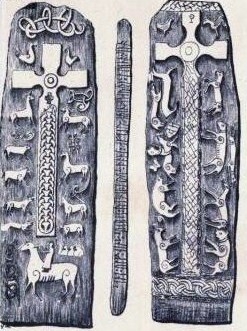Manx Viking Age Runestones

The Isle of Man is home to a remarkable number of carved crosses and monuments dating from the 5th century to the 12th century. Protected by the Manx National Heritage there are over 200 decorated stone crosses on the Island, most of which can be found in graveyards and churches. The earliest stones carry Celtic designs and inscriptions using an early Celtic script called Ogham. Later Norse sculptors decorated their crosses with both Christian icons and images from their own pagan mythology, along with Norse Runic inscriptions. Typifying the fusion of Gaelic and Norse cultures on the Isle of Man there are also unique monuments that combine Norse Runic inscriptions and Ogham inscriptions on the same stone.
The carved Manx stones with runic inscriptions were made by the Norse population on the Isle of Man during the Viking Age, mostly in the 10th century. The Island has 31 surviving stones with Scandinavian runic inscriptions from this period, which is nearly as many as in Norway. The Norse runes are the alphabet of the Old Norse language. That alphabet was called futhark and thought to have originated in around the 1st century AD. Broadly the types of Norse runes have been placed in two categories. The earlier and more complex Elder Futhark and the subsequent Younger Futhark. It is Younger Futhark that is associated with the Viking Age. Its rune symbols were more straightforward and easier to carve, consisting of 16 characters.
One example of such Manx runestones is that found in Kirk Andreas Church. It is dated to c. 940. It was erected in memory of a wife:
Old Norse transliteration:
Sandulfr hinn Svarti reisti kross þenna eptir Arinbjǫrgu, konu sína. ...
English translation:
"Sandulfr the Black erected this cross in memory of Arinbjǫrg his wife. ..
Image: Cumming, J. G. (1857) The Runic and Other Monumental Remains of the Isle of Man.






